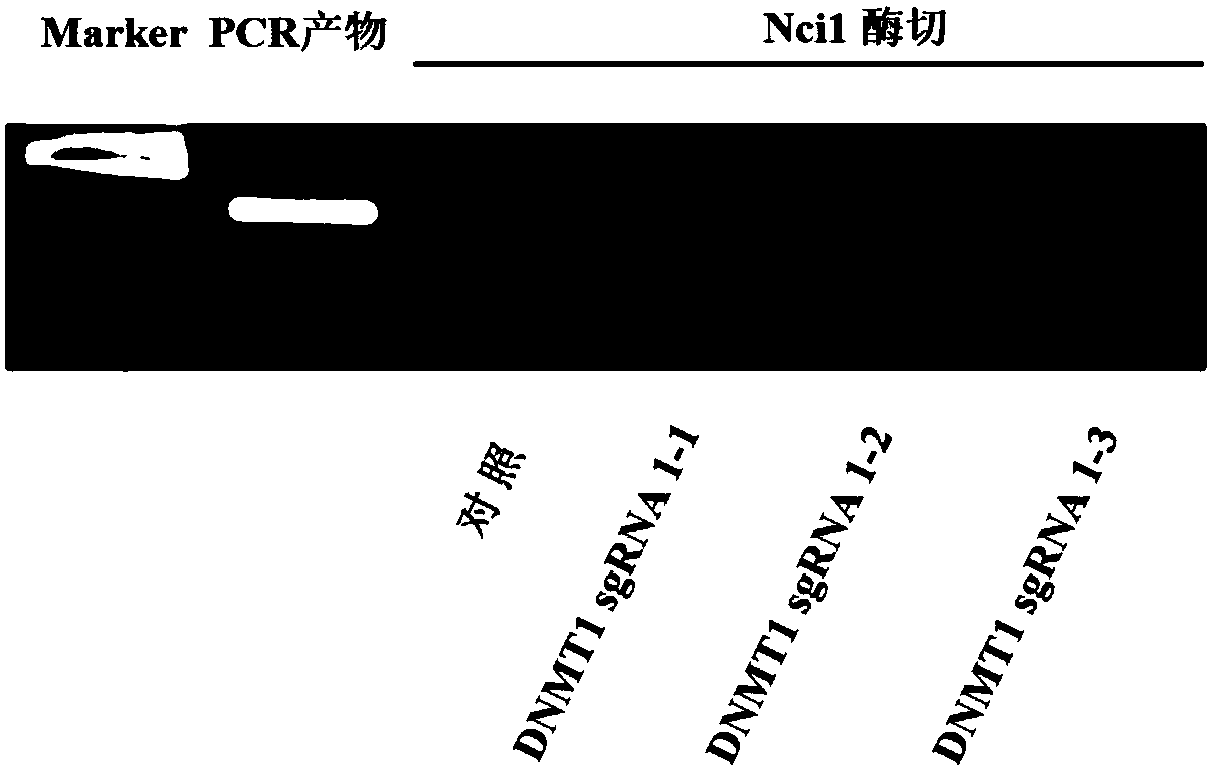Tumor-targeting gene therapy drug based on CRISPR/Cas9 gene editing technology and use thereof
A gene and targeting technology, applied in the field of tumor-targeting gene therapy drugs based on CRISPR/Cas9 gene editing technology and its application, can solve the problem of targeted knockout of tumor cell DNMT1 that is difficult to achieve therapeutic effect and cannot be effective, durable and stable Gene and other problems to achieve the effect of inhibiting the growth of tumor cells
- Summary
- Abstract
- Description
- Claims
- Application Information
AI Technical Summary
Problems solved by technology
Method used
Image
Examples
Embodiment 1
[0066] Example 1. Design of CRISPR-Cas9 to knock out sgRNA specifically targeting DNMT1 gene in human DNMT1 gene
[0067] 1. Select 5'-GN(18-21)GG on the human DNMT1 gene, where 3'-NGG is PAM. Therefore, the length of the sgRNA targeting the human DNMT1 gene is 18-21 bp.
[0068] 2. When designing sgRNA, use G as the starting base at the 5'end.
[0069] 3. The target binding region of sgRNA on the human DNMT1 gene is the conserved domain methyltransferase domain of the gene, that is, exons 31 and 32 of the human DNMT1 genome.
[0070] 4. Using online software (http: / / zifit.partners.org / ZiFiT / ) and supplemented by manual inspection, a total of 35 sgRNAs targeting exons 31 and 32 of the human DNMT1 genome were designed, which have targets The base sequence of the sgRNA that knocked out the human DNMT1 gene is shown in SEQ ID NO.: 1-7.
Embodiment 2
[0071] Example 2. Construction of sgRNA plasmid vector targeting human DNMT1 gene:
[0072] 1. Preparation of linear PX330 plasmid vector:
[0073] The reaction system is as follows:
[0074] PX330 plasmid vector: 3μg
[0075] BbsⅠ enzyme: 2μl
[0076] Buffer: 2μl
[0077] Double distilled water volume: 20μl
[0078] In the reaction system, the PX330 plasmid vector was digested with BbsI overnight to form a linear PX330 plasmid vector. The same method can be used to prepare linear PX459 granulation carrier.
[0079] 2. Design and double-stranded preparation of sgRNA oligonucleotide targeting human DNMT1 gene
[0080] (1) Select two of the sgRNAs designed in Example 1 (as shown in SEQ ID NO: 1 or 4 in the sequence table, respectively). According to the Bbs I digestion method used in the plasmid vector of step 1, in the selected Add the CACC linker to the 5'ends of the two sgRNAs to obtain the forward oligo; according to the selected sgRNA, obtain the complementary strand, and add the linke...
Embodiment 3
[0108] Example 3: Nci1 restriction enzyme digestion and Sanger sequencing method verify the sgRNA / Cas9-mediated targeted cleavage of the DNMT1 gene in SKOV3 cells
[0109] 1. SKOV3 cell plating culture:
[0110] The SKOV3 cells in the logarithmic growth phase were prepared as a cell suspension, and diluted with 10% FBS-1640 to 5×10 4 cells / ml, inoculate 100μl / well to a 96-well cell culture plate, 37.0℃, 5% CO 2 Cultivate for 24h under conditions. After the cells adhered, they were replaced with serum-free 1640 medium and starved for 24 hours.
[0111] 2. Liposome transfection method:
[0112] The PX459-DNMT1-1 plasmid (sgRNA sequence: SEQ ID NO: 1) constructed in Example 2 was transfected into the SKOV3 cells cultured in step 1 using the liposome transfection method (such as transfection reagent lipo2000), In the control group, SKOV3 cells were transfected with PX459 empty plasmid vector and incubated at 37°C for 24h.
[0113] 3. Screen positive cells with puromycin, collect the cells...
PUM
 Login to View More
Login to View More Abstract
Description
Claims
Application Information
 Login to View More
Login to View More - R&D
- Intellectual Property
- Life Sciences
- Materials
- Tech Scout
- Unparalleled Data Quality
- Higher Quality Content
- 60% Fewer Hallucinations
Browse by: Latest US Patents, China's latest patents, Technical Efficacy Thesaurus, Application Domain, Technology Topic, Popular Technical Reports.
© 2025 PatSnap. All rights reserved.Legal|Privacy policy|Modern Slavery Act Transparency Statement|Sitemap|About US| Contact US: help@patsnap.com



